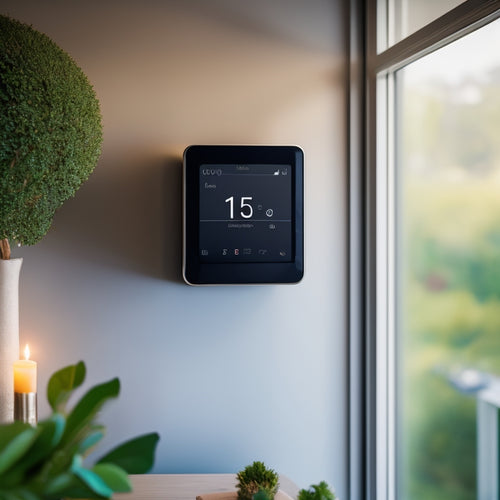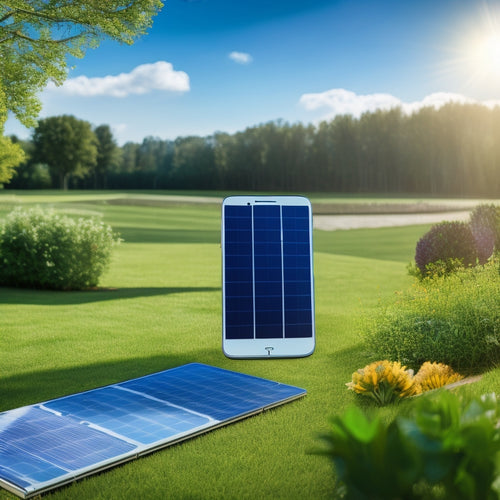
What WiFi Power Trackers Reveal About Home Energy?
Share
Your WiFi power tracker provides a granular breakdown of your home's energy consumption, revealing hidden patterns of energy waste, inefficient devices, and opportunities for significant cost savings. You'll gain access to real-time energy consumption data, identifying areas of waste and optimization opportunities. You'll uncover which devices are secretly guzzling energy, like your refrigerator and air conditioner, and how much energy they're stealing when in standby mode. You'll also reveal peak energy usage patterns, energy hogs in your home, and standby power consumption observations. By investigating these details, you'll unveil a path to reducing your energy bills and environmental impact, and there's more to investigate.
Key Takeaways
- WiFi power trackers provide real-time energy consumption data, identifying areas of waste and optimization opportunities in home energy usage.
- They reveal hidden energy-wasting appliances and devices, including those in standby mode, which can contribute up to 10% of energy bills.
- Energy monitoring and appliance tracking identify the biggest energy hogs in the home, enabling better control over energy consumption.
- WiFi power trackers help analyze peak energy usage patterns, allowing for adjustments to daily routines and optimizing solar panel design to reduce energy waste.
- They offer insights into standby power consumption, providing detailed breakdowns of energy usage and encouraging energy-efficient practices to reduce energy costs and environmental impact.
Real-time Energy Consumption Data
With WiFi power trackers, you gain access to real-time energy consumption data, enabling you to make informed decisions about your home's energy usage.
This data is vital in identifying areas of waste and opportunities for optimization. Through real-time monitoring, you can track your energy consumption patterns, pinpointing the times of day when usage spikes or dips.
By leveraging renewable energy sources, you can further reduce your carbon footprint and energy costs. Data visualization tools then help you make sense of this information, presenting it in a clear and actionable way.
Hidden Energy-Wasting Appliances
You're likely aware of the energy-hungry appliances in your home, like refrigerators and air conditioners, but what about the hidden energy-wasting culprits? These sneaky devices can greatly impact your energy consumption without you even realizing it.
For instance, did you know that integrating renewable energy solutions, such as solar power integration, can reduce your reliance on the grid and lower your carbon footprint? Additionally, using energy storage systems can optimize energy usage during off-peak hours, reducing costs and strain on the energy supply.
WiFi power trackers can help you identify these hidden energy-wasting appliances, providing useful observations into your appliance usage. By monitoring energy consumption in real-time, you'll uncover which devices are secretly guzzling energy.
You might be surprised to find that your TV, computer, or even coffee maker are contributing to your high energy bills. With this knowledge, you can take control of your energy usage, making informed decisions to reduce your energy waste and save money on your utility bills.
Energy Hogs in Your Home
Since many modern appliances are designed to consume power continuously, even when turned off or in standby mode, they can secretly inflate your energy bills.
You might be surprised to find out which devices in your home are the biggest energy hogs. With energy monitoring and appliance tracking, you can identify the culprits and take control of your energy consumption.
Furthermore, integrating renewable energy sources, such as solar energy, can reduce your reliance on the grid and carbon footprint.
WiFi power trackers can help you detect standby power consumption, also known as "vampire power," which can account for up to 10% of your energy bill.
Peak Energy Usage Patterns
Identifying energy hogs in your home is just the first step in gaining control over your energy consumption.
Now, it's time to plunge deeper into your energy trends. WiFi power trackers can reveal peak energy usage patterns, showing you when your energy consumption surges. You might be surprised to find that these usage spikes often occur during specific times of the day, like when you're cooking dinner or running multiple appliances simultaneously.
For instance, optimizing your solar panel array design can also help reduce energy waste. By selecting energy-efficient appliances and equipment, you can further minimize energy losses.
By analyzing these patterns, you can identify opportunities to adjust your daily routine and reduce your energy waste. For instance, you might consider running your laundry or dishwasher during off-peak hours when energy demand is lower.
With this knowledge, you can make informed decisions to optimize your energy usage and take control of your energy freedom.
Standby Power Consumption Insights
You're likely aware that your devices continue to draw power even when turned off but still plugged in. These "hidden energy vampires" can account for up to 10% of your home's total energy consumption.
By shifting to renewable energy sources like solar power, you can reduce your carbon footprint and energy bills. Additionally, achieving energy independence through solar-powered EV charging can minimize reliance on the grid and enhance your brand reputation.
Your WiFi power tracker can help you identify idle device drainers, revealing opportunities to reduce standby power consumption and shave dollars off your energy bill.
Hidden Energy Vampires
About 10% of your home's energy consumption is attributed to standby power, also known as "hidden energy vampires" or "vampire power."
These are devices that continue to draw power even when turned off but still plugged into an outlet. You might be surprised to learn that your TV, computer, and phone chargers are among the biggest culprits.
In addition, solar-powered stations can help reduce energy consumption and lead to potential tax credits, grants, and carbon credits.
Moreover, identifying these energy-wasting devices can also help reduce the cost implications of standby power, which can add up quickly.
By monitoring your energy usage, you can uncover areas where you can cut back and save on your energy bills.
The cost implications of standby power can add up quickly, so it's crucial to stay on top of your energy monitoring to maintain control over your energy usage.
Idle Device Drainers
When it comes to standby power consumption, idle device drainers are often the most egregious offenders.
You might be surprised to find that many of your devices continue to draw power even when turned off or in standby mode. This can add up quickly, especially if you have multiple devices plugged in at all times.
Using smart plugs and energy monitoring tools can help you identify which devices are the biggest culprits. By plugging your devices into smart plugs, you can monitor their energy usage in real-time, even when they're turned off.
This information can be eye-opening, and it's often the first step in making changes to reduce your overall energy consumption.
With this knowledge, you can take control of your energy usage and make informed decisions to reduce your environmental impact.
Home Energy Efficiency Opportunities
You've probably wondered which devices in your home are secretly guzzling energy when not in use.
By using WiFi power trackers, you can identify energy-wasting devices and hidden energy hogs that contribute to high energy bills.
Now, it's time to examine the opportunities to optimize your home's energy efficiency by addressing these unnecessary energy drains.
Energy-Wasting Devices Identified
Devices in standby mode, also known as "vampire" devices, continue to draw power from the grid even when turned off but still plugged in, wasting a significant amount of energy in the process.
You may be surprised to find that many devices in your home are guilty of this energy-wasting habit. WiFi power trackers can help you identify these energy-wasting devices, allowing you to take action to reduce your energy consumption.
Through device monitoring and energy audits, you can pinpoint which devices are using the most energy and make changes to optimize their performance.
Hidden Energy Hogs Found
Beyond the obvious energy-wasting culprits, such as TVs and computers, lurk hidden energy hogs that can considerably impact your home's energy efficiency. These sneaky devices continue to draw power even when turned off or in standby mode, contributing to standby power consumption. WiFi power trackers can help you identify these hidden energy hogs through energy monitoring and consumption analysis.
| Device | Standby Power (W) | Annual Energy Cost (USD) |
|---|---|---|
| Coffee Maker | 4.5 | 5.40 |
| Cable Box | 10.5 | 12.60 |
| Gaming Console | 2.5 | 3.00 |
Personalized Energy Savings Recommendations
Your WiFi power tracker provides a detailed breakdown of your energy usage, but its true potential lies in its ability to offer personalized energy savings recommendations adapted to your unique habits and preferences.
By analyzing your energy consumption patterns, the tracker identifies areas where you can cut back and provides customized observations on how to optimize your energy usage.
You'll receive tailored savings recommendations that take into account your lifestyle, appliance usage, and energy goals.
This personalized approach enables you to make informed decisions about your energy consumption, giving you the freedom to take control of your energy bills and reduce your environmental impact.
Frequently Asked Questions
Can Wifi Power Trackers Work With Older Appliances?
You can use WiFi power trackers with older appliances, but compatibility varies; some trackers support older devices, while others require specific appliance models or energy efficiency standards, affecting their ability to optimize energy consumption.
How Accurate Are Wifi Power Tracker Readings?
Are you skeptical about the numbers? You're right to question: WiFi power trackers' reading accuracy hinges on data reliability, which can be compromised by factors like signal strength, device compatibility, and calibration - so, take those readings with a grain of salt.
Are Wifi Power Trackers Compatible With Smart Home Systems?
You'll find that most WiFi power trackers seamlessly integrate with popular smart home systems, allowing you to utilize their energy management systems to optimize your home's energy usage and gain useful perceptions into your daily habits.
Do Wifi Power Trackers Require Frequent Battery Replacement?
As you maneuver through the domain of smart home devices, you'll find that WiFi power trackers, like a loyal sentinel, require minimal battery maintenance, boasting a battery lifespan of up to 10 years, thanks to energy efficiency design, granting you freedom from frequent replacements.
Can Wifi Power Trackers Monitor Energy Usage in Multiple Homes?
You can monitor energy usage in multiple homes with WiFi power trackers, utilizing advanced energy management features that enable multi-home monitoring, allowing you to track and control energy consumption across different locations effortlessly.
Related Posts
-

3 Sun-Powered Automated Shades for Energy-Savvy Homes
You're looking to change your home into an energy-savvy haven, and sun-powered automated shades are an essential step...
-

Smart Energy: Greener Homes With Connected Power Devices
You can control and optimize your energy consumption with smart energy devices, reducing your carbon footprint by up ...
-

7 Best Solar Panel Upkeep Apps for Homeowners
You can optimize your solar panel's energy output and efficiency by up to 20% with regular maintenance, which is wher...


